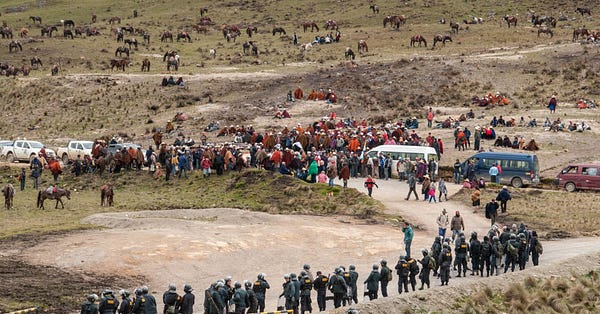Climate technologies require enormous amounts of metal. I’m Ian Morse, and this is Green Rocks, a newsletter that doesn’t want dirty mining to ruin clean energy.
How do you make copper carbon neutral? According to mining giant BHP Billiton, all it takes is some blockchain software, a protected forest, and roughly $200,000.
In September last year, BHP announced it loaded copper from its mines in Chile onto a ship headed for a cathode manufacturer in the US state of Georgia called Southwire. Both companies then bought offsets from the Alto Mayo Protected Forest in Peru. The two companies tracked the shipment with Circulor’s blockchain-based technology and carried out two shipments.
In total, BHP and Southwire bought 17,496 credits – which should be equivalent to 17,496 tons of carbon emissions. According to price estimates I obtained from Allied Offsets for a story in Mongabay, those purchases cost more than $230,000. The Alto Mayo Conservation Initiative used the money to make sure trees were not cut down. By buying the offsets, the normal rate of deforestation declined, and it’s as if the shipping emissions didn’t occur. BHP says these are “high-quality” offsets.
Who decides the ‘normal’ rate of forest loss? How do you prove a change from this norm? How does the project involve people living off the forest? Lauren Gifford, who did part of her PhD research in Alto Mayo, calls the project “carbon colonialism.” When Bloomberg reporters traveled there in 2020, they found the project had exacerbated conflicts between the government and villagers who had long lived in the area but were suddenly treated like trespassers. From an interview with Gifford on the Earth Watch program:
So when forest carbon sequestration for climate mitigation is privileged above all other forest uses, it then deprioritizes other forest uses, other livelihoods, cultural uses, traditional industries, things like that, that rely on the forest.
Alto Mayo receives credits only when it has proven that without its work, trees would have been cut down. It’s hard to prove a counterfactual. The project depends on estimating baseline emissions that would have occurred without the sale of credits. In this case, the project says that without the money, people living in the area would convert forest to coffee plantations. After researchers pointed out the project inflated the rate of deforestation by a factor of three, project leader Conservation International softened its language about its success. More recently, researchers have questioned why the project continues expanding even as staff acknowledge failure. Experts say forest-based offset projects like this have the highest risk of failing to contribute to emissions reductions.
Meanwhile, BHP backtracked its plan to stop producing coal after prices rose.


Carbon offsets have appeared across the mining industry. BHP intends to use them to contract a carbon neutral conveyor belt at a copper mine in Chile. Foran Mining is using them to deem its copper exploration activities in Canada as the world’s first carbon neutral copper project. Mayfair Gold called itself a carbon neutral gold project after it bought credits from a project installs solar heating systems in Canada. BHP is working with Australian officials to calculate and issue credits for carbon stored in waste piles. Vale has used carbon offsets more explicitly to support its net-zero commitment.
Recent News
US Republicans plan to visit COP27 to encourage actors to develop mineral supplies for the “new energy world”.
Germany, Costa Rica and Spain have told the International Seabed Authority to pause discussion on deep-sea mining. France used its COP27 speech to do the same.
Canada has ordered three Chinese companies sell their lithium assets after it imposed limits on foreign involvement in critical minerals. (Half of Canadian mining companies own foreign mineral assets.)
Representatives of an Indigenous community near a Chinese copper mine in Peru have proposed they become shareholders in the company after several blockades.
Two workers died at a South32 aluminum smelter in Mozambique.
Two workers were rescued after nine days trapped in an underground zinc mine in South Korea.
Indonesia is looking into creating a OPEC-like cartel for nickel and other battery metals. Brazil’s new president has also proposed a rainforest alliance with Indonesia and the DRC.
A Chinese gold company in the DRC continues to operate after evidence of mercury use surfaced and ministry officials told the company to shut down.
The owner of the richest EV company is worrying environmentalists after a social media company saw spikes in climate disinformation and hate speech after he bought it.
Reads
≠ endorsement
EV Mineral Bonanza on Alaska Tribal Land Turns on Disputed Road (Bloomberg Law)
Battle Over Deep-Sea Mining Takes on New Urgency as Trial Run Winds Down (New York Times)
Canadian mining project in Guatemala opposed in local vote over environmental concerns (The Conversation)
Dirty metals for clean cars: Indonesian nickel could be key to EV battery industry (Nikkei Asia)
Shady contracts, backdoor deals spur illegal gold mining in Bolivian Amazon (Mongabay)
Mining isn’t living up to its own hype (Financial Times)






Interesting!
Please let's not forget the environmental damage- beyond emissions - BHP causes in their mining sites, particularly on Andean salt flats and wetlands such as Punta Negra, Atacama (Minera Escondida Project) and Pampa Lagunilla (Cerro Colorado Project). Funny this damage isn't even exchangeable for offset projects and they manage to "compensate" and "mitigate" putting lots of money just locally.
https://observatoriosalares.wordpress.com/2020/01/14/minera-escondida-bhp-billiton-un-buen-vecino-en-el-salar-de-atacama/
Best,
Ramón Balcázar M. / Plurinational Observatory of Andean Salt Flats OPSAL
https://open.substack.com/pub/finiche/p/portfolio-insights?utm_source=direct&r=1s05vd&utm_campaign=post&utm_medium=web